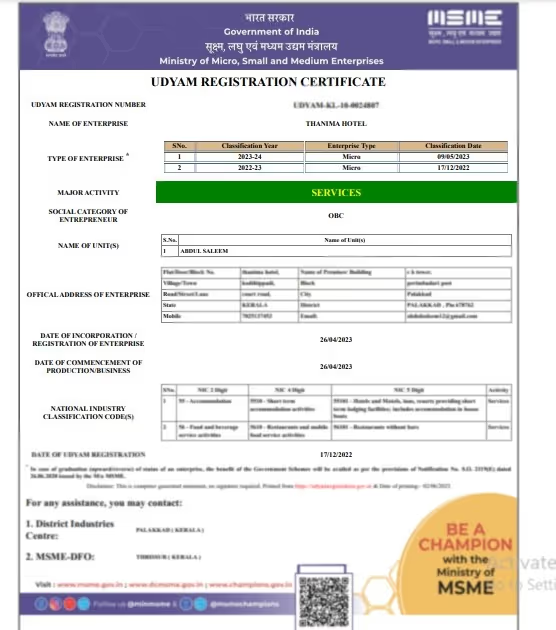Starting a business in India is an exciting and transformative journey, filled with opportunities to bring your ideas to life and create something impactful. However, one of the most crucial decisions you’ll face early on is choosing the proper business structure. Think of it as laying the foundation for your venture—get it right, and it supports your growth; get it wrong, and it could lead to unnecessary challenges down the line.
Each business type has its own advantages, legal responsibilities and operational requirements, making it essential to align your choice with your goals, resources and long-term vision.
In this blog, we’ll simplify the complexities, walking you through the different types of companies in India, their features, benefits and the documents required to get started.

Table of Contents
What Are the Types of Business Entities?
India’s vibrant economy is home to diverse industries and entrepreneurial ambitions, necessitating a range of business entity options. From solo ventures to large-scale collaborations, the choice of business structure directly impacts a company's growth, legal compliance, tax obligations and operational efficiency.
There are different types of companies in India, ranging from individual ownership models to multi-member organisations, catering to various needs and scales. These include:
- Sole Proprietorship
- Limited Liability Partnerships (LLP)
- Private Limited Companies
- One Person Companies (OPC)
- Section 8 Companies
- Partnerships
- Public Limited Companies
- Joint-Venture Companies
- Non-Government Organisations (NGOs)
Types of Business Structures in India
India offers a variety of business structures to suit different entrepreneurial needs, scales and industries. Each structure has unique features, benefits and drawbacks, making it crucial to choose the right one based on your business goals. Let’s dive deeper into different types of businesses in India:
- Sole ProprietorshipA sole proprietorship is the simplest and most commonly adopted business structure in India, especially for small businesses or individual entrepreneurs. It is an unincorporated business owned and managed by a single person.
Features:- No separate legal entity; the business is considered the same as the owner.
- Unlimited liability: The owner's personal assets are at risk in case of debts.
- Minimal compliance: Easy to set up and operate with fewer regulations.
- PartnershipA partnership is a business structure where two or more individuals share ownership, profits and responsibilities. It is governed by the Indian Partnership Act of 1932 and is ideal for businesses requiring diverse skill sets.
Features:- Joint ownership and decision-making.
- Unlimited liability for all partners unless specified otherwise in the partnership agreement.
- No perpetual succession; the partnership dissolves upon a partner's death or withdrawal.
- Limited Liability Partnerships (LLP)An LLP blends the advantages of a partnership with the benefits of limited liability. Introduced under the LLP Act of 2008, it is ideal for professionals or small businesses looking for a flexible yet secure structure.
Features:- Combines the flexibility of partnerships with limited liability protection.
- A separate legal entity from its partners.
- Requires at least two designated partners.
- Private Limited Companies (Pvt Ltd)A Private Limited Company is a favoured structure among startups and small-to-medium enterprises with several advantages. It is governed by the Companies Act of 2013 and allows for limited liability while offering scalability.
Features:- Separate legal identity from its owners.
- Limited liability for shareholders.
- Eligibility to issue shares for raising funds.
- Public Limited CompaniesA Public Limited Company is suitable for businesses aiming to scale operations and raise public funds through shares. A company whose shares are publicly traded, with ownership open to the general public.
Features:- Requires a minimum of seven shareholders and three directors.
- No upper limit on the number of shareholders.
- Vulnerable to market fluctuations.
- One Person Companies (OPC)Introduced under the Companies Act of 2013, an OPC caters to solo entrepreneurs seeking limited liability benefits. Simply put, a single individual owns the company while enjoying limited liability protection.
Features:- Mandatory to appoint a nominee.
- Limited liability for the owner.
- Not eligible for equity funding.
- Section 8 Companies (NGOs)Section 8 Companies are nonprofit organisations formed under the Companies Act of 2013 to promote social welfare activities. These companies focus on charitable objectives like education, healthcare or environmental protection.
Features:- Profits cannot be distributed as dividends.
- Tax exemptions are available under specific conditions.
- Joint-Venture CompaniesA Joint- Venture (JV) combines two or more entities to collaborate on a specific project or goal. Partners share resources, expertise and profits while retaining their individual entities.
Features:- Operates under a joint agreement for a specific purpose.
- Temporary or long-term collaboration.
- Shared financial risks.
- Non-Government Organisations (NGOs)NGOs are entities dedicated to social welfare causes, operating independently of the government. NGOs can be structured as trusts, societies or Section 8 Companies, focusing on various charitable activities.
Features:- Operates without a profit motive.
- May qualify for tax exemptions.
- Drives social change and community development.
Types of Companies Based on Size
In India, companies can be categorized based on their size, typically determined by factors such as turnover, capital investment, and employee count. Here are the main types of companies in India based on size:
Here are the main types of companies based on members:
1. Micro Enterprises
Micro-enterprises are the smallest category of companies, characterized by low investment in plant and machinery or equipment. In India, micro-enterprises are defined as those with an investment of up to Rs. 1 crore in manufacturing and an annual turnover of Rs. 5 crore.
2. Small Enterprises
Small enterprises are slightly larger than micro-enterprises but still fall within the small-scale sector. In India, small enterprises are defined as those with an investment of not more than Rs. 10 crore and an annual turnover of not more than Rs. 50 crore.
3. Medium Enterprises
Medium enterprises are larger than small enterprises but smaller than large corporations. In India, medium enterprises are defined as those with an investment of more than Rs. 50 crore in manufacturing and an annual turnover of not more than Rs. 250 crore.
4. Large Enterprises
Large enterprises are the largest category of companies, characterized by substantial investment, high turnover, and a large workforce. In India, large enterprises have investments exceeding Rs. 50 crore in manufacturing or Rs. 250 crore in services. They often have hundreds or even thousands of employees and operate nationally or multinational.
These categories are defined by the Ministry of Micro, Small, and Medium Enterprises (MSME) in India to provide various benefits and incentives to small and medium-sized enterprises (SMEs), such as priority lending, subsidies, tax exemptions, and easier access to government schemes and programs.
Types of Companies Based on Liabilities
Companies can be categorized based on the extent of liability their members or owners have. Some major types of companies based on liabilities are-
1. Company Limited by Shares
A Company Limited by Shares is a type of company where the liability of its members is limited to the amount unpaid on their shares. This means that shareholders are not personally liable for the company's debts beyond the amount they have agreed to contribute towards the shares they hold.
Companies Limited by Shares can be further classified into private limited companies and public limited companies based on the number of shareholders and other criteria.
2. Company Limited by Guarantee
In a Company Limited by Guarantee, the liability of its members is limited to the amount they agree to contribute to the company's assets in the event of its winding up. This type of company is commonly used for non-profit organizations, clubs, societies, and associations.
3. Unlimited Liability Company
In an Unlimited Liability Company, the members or owners have unlimited personal liability for the company's debts and obligations. This means that their personal assets are at risk to satisfy the company's liabilities, and creditors can pursue the members' personal assets to settle debts owed by the company.
Types of Companies Based on Listing Status
Companies can also be classified based on their listing status, which refers to whether their shares are listed on a stock exchange for public trading.
1. Listed Companies
Listed companies are those whose shares are listed and traded on a recognized stock exchange, such as the Bombay Stock Exchange (BSE) or the National Stock Exchange (NSE) in India.
These companies are subject to stringent regulatory requirements and disclosure norms mandated by the Securities and Exchange Board of India (SEBI). Listing provides liquidity to shareholders and enables the company to raise capital by issuing additional shares to the public.
2. Unlisted Companies
Unlisted companies are those whose shares are not traded on any stock exchange. These companies may be privately held, meaning that their shares are owned by a small group of shareholders or closely held by promoters and investors.
Unlisted companies are not subject to the same level of regulatory scrutiny as listed companies but may still be required to comply with certain statutory requirements under the Companies Act.
Types of Companies Based on Holding
Companies can be categorized based on their holding structure, which refers to the relationship between parent companies and their subsidiaries.
1. Parent Company
A parent company is a corporation that owns a controlling interest in one or more subsidiary companies. It typically holds more than 50% of the voting rights in the subsidiary companies and has the power to make decisions affecting their operations and strategic direction.
2. Subsidiary Company
A subsidiary company is a company that is controlled by another company, known as the parent company. Subsidiary companies can be wholly or partially owned by the parent company, depending on the percentage of shares held.
Subsidiary companies operate independently but are subject to the control and influence of the parent company.
3. Holdings Company
A holdings company is a company whose primary purpose is to hold investments in other companies rather than engage in operational activities. Holdings companies typically own shares in subsidiary companies and may provide their subsidiaries with strategic direction and financial support.
Unlike a parent company, a holding company does not engage in business operations of its own.
4. Affiliate Company
An affiliate company is a company that is related to another company through common ownership or control. Affiliate companies may be part of the same corporate group or have a strategic partnership with each other.
5. Associate Company
An associate company is one in which another company holds a significant but not controlling interest, usually between 20% to 50% of the voting rights. While the investing company has influence over the associate company's operations and management, it does not exercise full control.
Documents Required to Open Different Types of Business in India
Here’s a list of documents required to open a company in India:
- Identity Proof: PAN card, Aadhaar card
- Address Proof: Utility bill, rent agreement, or property papers
- Business Registration Forms: Forms based on the business type (SPICe+, FiLLiP, etc.)
- Digital Signature Certificate (DSC): For online submissions
- Proof of registered office address: NOC or Rental Agreement
Additional documents may be required based on the business type, such as MOA and AOA for companies, LLP Agreements for LLPs or trust deeds for NGOs.
Conclusion
In India, the variety of business entities ensures there’s a fit for every kind of entrepreneur—whether you're a solo dreamer with a big vision, a small team building something impactful, or an organisation driven by social change.
Each type of entity offers unique features, advantages and challenges. From the simplicity of a sole proprietorship to the robust framework of private limited companies or the flexibility of LLPs, picking the right one can make your journey smoother, protect your personal assets and set you up for growth.
Think about your business goals:
- Do you want to stay small and agile or scale into a large organisation?
- Do you need investors or want to keep it self-funded?
- Are compliance and taxes manageable?
Your answers to these questions will guide you toward the perfect fit. If you’re unsure where to start, don’t worry—many successful entrepreneurs were in the same place when they started. The key is to take it one step at a time.
Frequently Asked Questions
Private Limited Company
(Pvt. Ltd.)
- Service-based businesses
- Businesses looking to issue shares
- Businesses seeking investment through equity-based funding
Limited Liability Partnership
(LLP)
- Professional services
- Firms seeking any capital contribution from Partners
- Firms sharing resources with limited liability
One Person Company
(OPC)
- Freelancers, Small-scale businesses
- Businesses looking for minimal compliance
- Businesses looking for single-ownership
Private Limited Company
(Pvt. Ltd.)
- Service-based businesses
- Businesses looking to issue shares
- Businesses seeking investment through equity-based funding
One Person Company
(OPC)
- Freelancers, Small-scale businesses
- Businesses looking for minimal compliance
- Businesses looking for single-ownership
Private Limited Company
(Pvt. Ltd.)
- Service-based businesses
- Businesses looking to issue shares
- Businesses seeking investment through equity-based funding
Limited Liability Partnership
(LLP)
- Professional services
- Firms seeking any capital contribution from Partners
- Firms sharing resources with limited liability
Frequently Asked Questions
What Type of Business Is More Profitable?
The profitability of a business depends on various factors, including the industry, business model and operational efficiency. For instance:
- Technology startups have high profit potential due to scalability.
- Service businesses, like consulting or digital marketing, often have low initial costs and high margins.
- E-commerce can be highly profitable if inventory and logistics are managed efficiently.
- Real estate and manufacturing tend to yield long-term gains but require significant capital.
Ultimately, the most profitable business aligns with the entrepreneur’s expertise and market demand.
Why Do Different Types of Businesses Exist?
Different types of businesses exist to cater to the diverse needs of entrepreneurs, industries and regulatory requirements.
- Legal and financial considerations: Some businesses need limited liability, while others prioritise simplicity.
- Operational scope: A sole proprietor might work well for small-scale operations, while large organisations need a corporate structure.
- Growth potential: Some structures, like private limited companies, attract investors, while others, like partnerships, foster collaboration.
What Types of Businesses Are in Demand?
Currently, high-demand businesses include:
- Technology and SaaS: Cloud computing, AI and software solutions.
- E-commerce: Online retail continues to grow post-pandemic.
- Health and wellness: Telemedicine, fitness and organic products are booming.
- Sustainable businesses: Eco-friendly products and renewable energy.
- Digital services: Marketing, content creation, and app development.
These industries reflect shifting consumer priorities and technological advancements.
What Are the Five Types of Business Organisations?
The five major types of business organisations are:
- Sole Proprietorship: Owned and managed by one person; simple and cost-effective.
- Partnership: Owned by two or more individuals sharing responsibilities and profits.
- Limited Liability Partnership (LLP): A hybrid structure with limited liability and partnership benefits.
- Private Limited: A separate legal entity that can raise capital by issuing shares.
- Public Limited: Allows a company to offer shares to the general public, either on the stock market or privately.
What Is the Director Identification Number (DIN)?
The Director Identification Number (DIN) is a unique identification number assigned by the Ministry of Corporate Affairs (MCA) in India to individuals intending to serve as company directors. It is mandatory under the Companies Act of 2013.

















